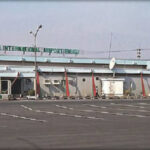While education is a core component of any economy, it’s sad that it’s being hindered by factors such as poverty and inadequate infrastructures.
School facilities affect teacher recruitment, retention, commitment, and effort. While for students, it affects their health, engagement and learning. Therefore without adequate resources, it is very difficult to serve a large number of children.
In Kano State for instance, Tofa Model Primary school Janguza is affected by inadequate classroom size and space. The school is well-equipped thanks to United Nations Children’s Fund (UNICEF) who supplied some infrastructural facilities such as furniture, boards etc but their biggest problem is over-population of students. What this means is that a lot of children who wants to be enrolled in schools will have to be turned back because of inadequate space.

In Overcrowded schools, students find themselves trying to learn while jammed into small spaces and this creates a heavy workload for the teachers who spend most of the time trying to manage the students.
The effects of inadequate infrastructural facilities on students are as follows:
(1) Inadequate classroom spaces have resulted in overcrowding in schools which has led to the to the production of half-baked students.
In cases where a school is overpopulated, most teachers don’t have the time to access every student to find out their educational strengths. The teachers most times pick maybe 5 or 10 students and concentrate on them. The rest are most probably labeled as dullards.
ALSO READ: 10 Reasons Why The Girl Child Should Access Quality Education
2). Many teachers no longer find their job interesting and satisfactory because of the lack of facilities to carry out their job. No matter how committed and enthusiastic a teacher might be, his or her effort in the classroom might not produce the required result in teaching and student management.
Overcrowding of a classroom creates stressful working conditions for teachers and this is why a lot of teachers in government schools play truancy and most times skip work to attend to their side business. There is little or no motivation for teachers and this leads to Brain-Drain Syndrome. The reward system in cash or fringe benefit cannot be compared with other professions. This is responsible for the high rate of trained teachers who abandon teaching for more lucrative professions.
3). Lack of Basic Amenities for students: – When a school is overcrowded, infrastructure like Toilets becomes a problem. In a school where there are 10 toilets and the students are over 1000, the toilets won’t be enough for the students and this brings up the issue of poor hygiene in schools.
Causes Of Lack of Infrastructure in Schools
(1). Corruption is the biggest factor affecting the lack of infrastructure in schools. Kano State for instance receives the highest allocation from the Federal Government but the percentage allocated to education is poor.
Nigerian Government officials embezzle the funds and materials allocated to them to cater for the masses and fund departments like education and health but they prefer to enrich themselves to the detriment of the general well-being of its citizens.
They end up inflating contracts for the procurement of educational materials, equipment such as items for laboratories, furniture which includes chairs, boards, desks and books.
DON’T MISS: How Poverty Hinders Education In Northern Nigeria
(2) Inadequate Funding of Schools: The failure to prioritize the use of available funds that would cover areas of need like: employing qualified teachers, procuring textbooks and teaching aids, improving on existing infrastructures, has resulted in the absence of well-equipped laboratories in schools, insufficient chairs, desks and not enough recreational facilities for students.
3). Deliberate moves by Northern Oligarchs to prevent the spread of education. So they can continue having the Northern masses under their control.
This is something that’s not been discussed openly. But it’s believed that the Northern Elites and rulers actually don’t want the masses educated. They prefer a situation whereby they have the poor masses line up daily at their house to receive food and daily stipends. This is sad but the reality of what happens in Northern Nigeria.
4). Equity in the distribution of school resources. Our government is fond of providing the necessary facilities in schools in the cities where the masses are likely to see and say ”YES, this government is working” but ignore the schools in rural areas.
The select only the schools in highbrow areas to receive funding and materials. Forgetting that the high brow areas also have lots of private schools and parents don’t want their kids attending public schools.
So the right thing to do is pump more money into schools in the rural areas so the standard of education can reach the level of those located in high brow areas.
Below is a video of a teacher at Tofa model school Janguza, Kano state who spoke to me about the need for more classrooms at Tofa model school.
READ: UNICEF, FG partners with bloggers to promote child rights & access to education
In Conclusion, research has shown that school facilities impact teaching and learning in several ways. Yet our lawmakers over-look the impact educational facilities play in improving the learning environment for both students and teachers. While improving facilities comes at a financial cost, the benefits of such investments often surpass the initial costs. Policymakers, thus, should focus greater attention on the impacts of facilities and adopt a long-term cost-benefit perspective on efforts to improve school facilities.
RELATED STORIES:
Nigerian Man, Timilehin Bello Named One Of The Top 25 Innovators In Europe, Middle East And Africa – Read More
Mrs Aisha Buhari Honours Airport Cleaner Who Returned A Lost Bag Containing Lots Of Cash – Read More




![Two African Cardinals Among 15 Possible Replacements For Pope Francis [Full List] 5 Two African Cardinals Among 15 Possible Replacements For Pope Francis [Full List]](https://media.kanyidaily.com/2025/04/21181630/Successors-To-Pope-Francis-1-150x150.jpg)

![Christians Hold Peace Walk To Honour Victims Of Plateau Killings [Video] 9 Christians Hold Peace Walk To Honour Victims Of Plateau Killings [Video]](https://media.kanyidaily.com/2025/04/21154705/All-Videos-Edit.05_46_52_07.Still2694-1-1536x864-1-150x150.jpg)








